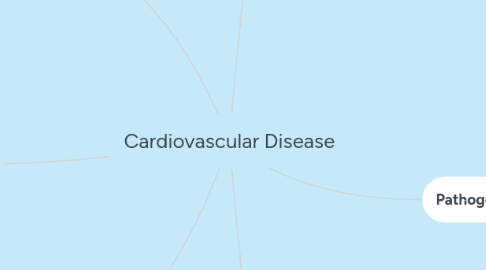
1. Diagnosis
1.1. Angioplasty
1.1.1. Performed x10 more than bypass
1.2. x-ray examination w/ dye
1.3. Echocardiogram
1.4. exercise treadmill testing
1.5. Fast CT
1.6. MRA
2. Clinical Presentation
2.1. Extreme fatigue
2.2. Dizziness
2.3. >100bpm
2.4. Irregular Heartbeat
2.5. Difficulty breathing
2.6. Chest pain
3. Medical Interventions
3.1. Surgery
3.1.1. PTCA
3.1.2. CABG
3.1.3. coronary stents
3.1.3.1. Drug coated stents
3.1.3.1.1. bare metal w/ polymer coating
3.1.3.1.2. Less likely to cause clots
3.1.3.2. Taken with aspirin to prevent a thrombosis
4. Epidemiology
4.1. 1/3 deaths in US
4.2. Risk Factors
4.2.1. HTN
4.2.2. High Cholesterol
4.2.3. Smoking
4.2.4. 1/2 US population >20 has one of these
4.3. Prevention Strategies
4.3.1. Primary prevention
4.3.1.1. reducing chances of 1st event
4.3.1.2. Done through:
4.3.1.2.1. Lifestyle changes
4.3.1.2.2. Environmental Changes
4.3.2. Secondary prevention
4.3.2.1. decrease the recurrent CV events
4.3.2.2. Reduce death resulting form CVD
4.3.3. Premordial prevention
4.3.3.1. far-reaching idea
4.3.3.1.1. AHA supports concept
4.3.3.2. Includes:
4.3.3.2.1. CV risk are observed early in healthy children
4.3.3.2.2. preserved in adulthood
5. Pathogenesis
5.1. Signs & Symptoms
5.1.1. Chest, neck or arm pain/discomfort
5.1.1.1. Arise secondary to
5.1.1.1.1. Ischemia
5.1.1.1.2. MI
5.1.1.1.3. pericarditis
5.1.1.1.4. endocarditis
5.1.1.1.5. mitral valve prolapse
5.1.1.1.6. OR aortic dissection
5.1.1.2. Associated S&S
5.1.1.2.1. nausea
5.1.1.2.2. vomiting
5.1.1.2.3. diaphoresis
5.1.1.2.4. dyspnea
5.1.1.2.5. pallor
5.1.1.2.6. syncope
5.1.2. palpitations
5.1.2.1. irregular, fast or "extra" heartbeat
5.1.2.2. Occur from burst of adrenaline
5.1.3. dyspnea
5.1.3.1. SOB
5.1.4. leg pain (claudication)
5.2. Aging
5.2.1. Effects
5.2.1.1. reduction in myocytes & cells w/i the conductive tissue
5.2.1.2. cardiac fibrosis
5.2.1.3. Reduced calcium transport across membrane
5.2.1.4. lower capillary density
5.2.1.5. decreases in response to B-andrenergic stimulation
5.2.1.6. impaired autonomic reflex control of HR
5.3. Gender:
5.3.1. Women
5.3.1.1. Hearts
5.3.1.1.1. Structurally different
5.3.1.1.2. Smaller
5.3.1.1.3. > chance of mitral valve prolapse
5.3.1.2. Puberty
5.3.1.2.1. QT interval increases
5.3.1.3. 3x greater risk of fatal arrhythmias using medication
5.3.1.4. Decision delay
5.3.1.4.1. time before seeking help for acute MI
5.3.1.5. develop HTN
5.3.1.6. > half of women over 55 need to lower cholesterol
5.3.1.6.1. Post menopause
6. PT implications
6.1. Exercise has shown to
6.1.1. risk for coronary events
6.1.2. ischemic stroke
6.1.3. metabolic syndrome
6.1.4. insulin resistance
6.1.5. diabetes mellitus
6.2. Education on a healthy lifestyle
6.2.1. Exercise keeps inner lining of arteries healthy
6.2.1.1. & less prone to injuries that lead to plaque formation
6.2.2. A low fat diet
6.2.3. Stress management
6.2.4. Improved endothelial function and reduced inflammatory markers

